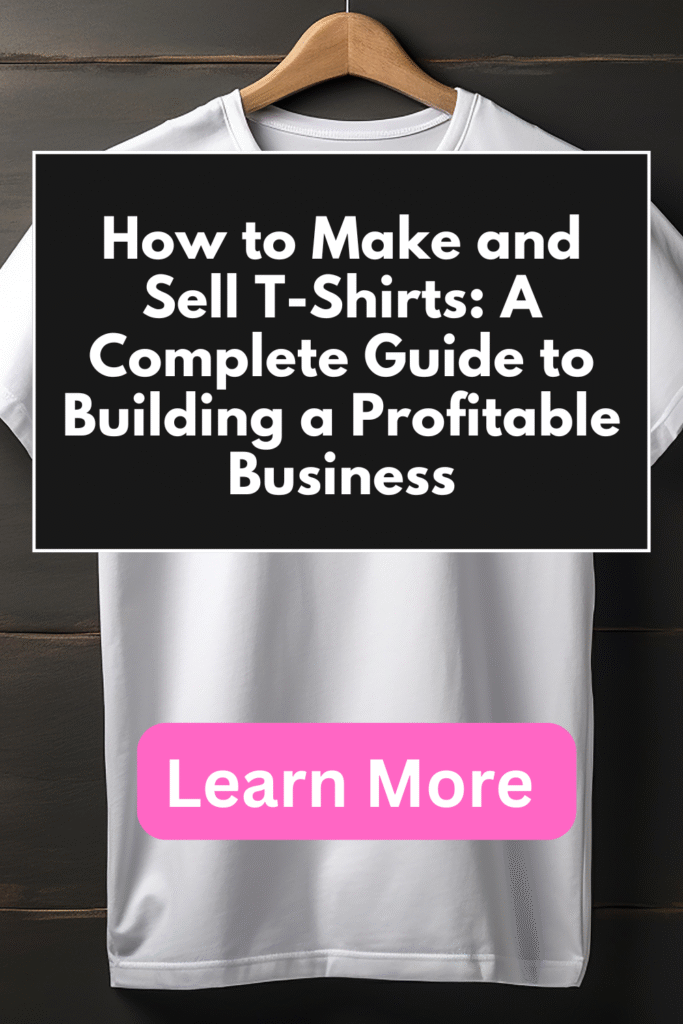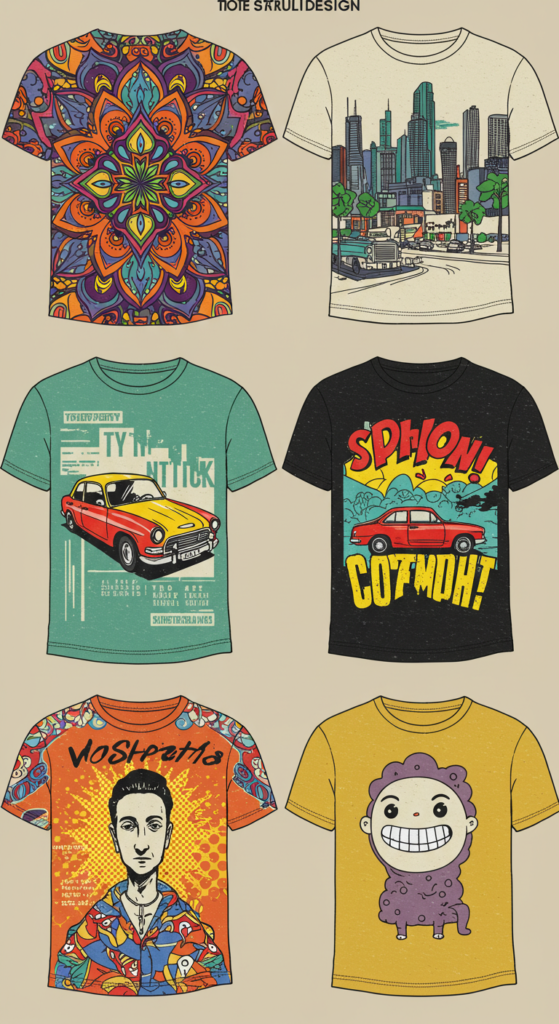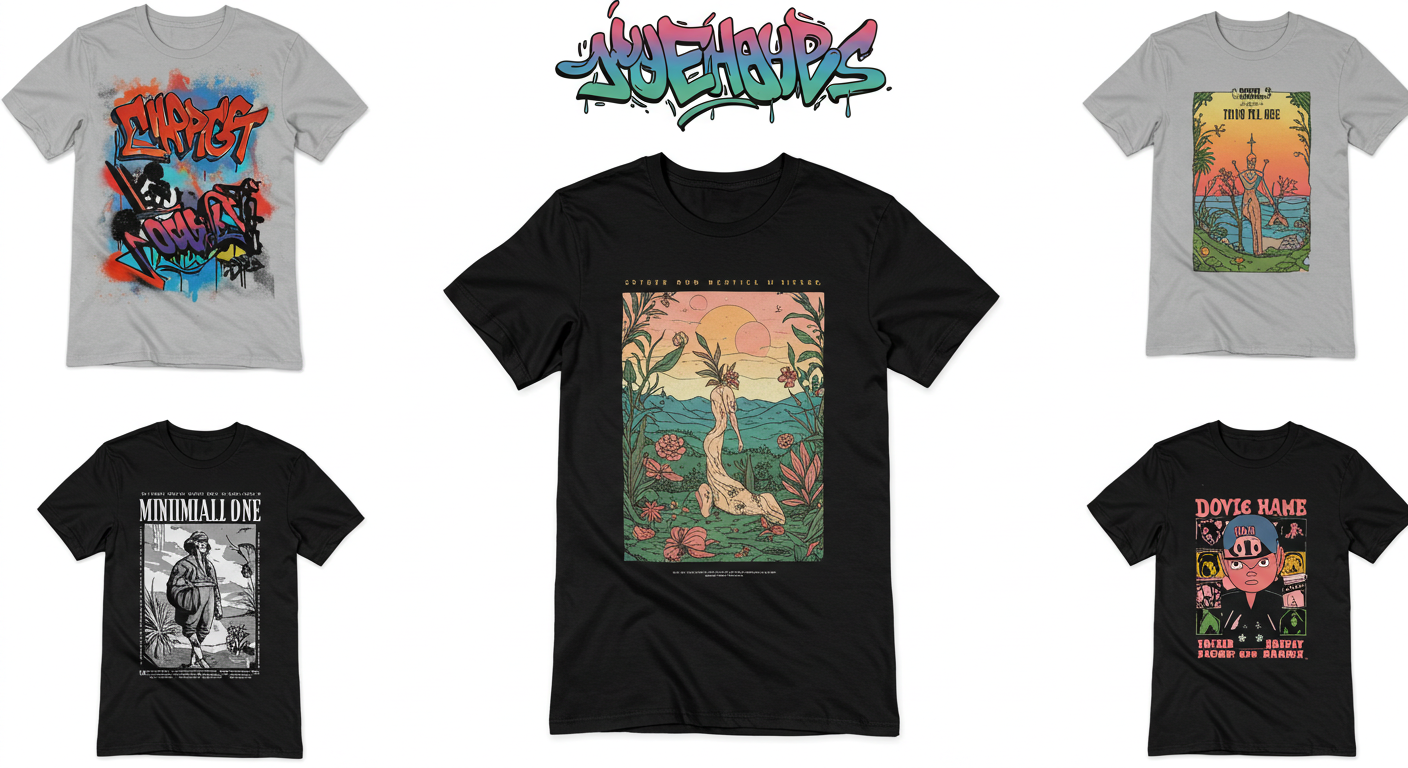Starting a t-shirt business can be an exciting venture, especially for those with a creative streak. The t-shirt industry is massive, with endless opportunities for unique designs, catchy slogans, and niche markets. Whether you’re looking to make a living or build a side hustle, making and selling t-shirts online is a great way to express your creativity and generate income.
In this article, we’ll walk you through everything you need to know to make and sell t-shirts, from designing your products to marketing and scaling your business.
Key Takeaway
Starting a t-shirt business offers a unique blend of creativity and profit potential. To succeed, focus on these key steps:
- Find Your Niche: Identify a target audience and create designs that appeal to their interests or needs.
- Choose the Right Printing Method: Whether it’s screen printing, heat transfer, or print-on-demand, pick the method that aligns with your business goals and budget.
- Set Up an Online Store: Use platforms like Shopify or Etsy to showcase your designs and sell directly to consumers.
- Market Your Brand: Leverage social media, influencer partnerships, and email marketing to reach a wider audience.
- Scale Your Business: Keep expanding your product range, adding new designs, and exploring international markets to grow your t-shirt business.
With persistence and creativity, you can turn your t-shirt designs into a profitable venture.
Why Start a T-Shirt Business?
The t-shirt industry has been booming for years, and with the rise of e-commerce, selling t-shirts has become more accessible than ever. Here are a few reasons why starting a t-shirt business can be a great idea:
- Low Startup Costs: Compared to many other businesses, starting a t-shirt business requires minimal investment. You don’t need a physical store, and you can start small with a limited number of designs and inventory.
- Creative Freedom: The t-shirt industry allows you to showcase your artistic skills, whether you’re into graphic design, typography, or photography. You can create t-shirts that align with your personal style or cater to niche audiences.
- Scalability: A t-shirt business can scale quickly with the right strategies in place. As your designs gain popularity, you can expand your product range, increase your marketing efforts, and sell in different regions.
- Potential for Passive Income: With platforms like Print on Demand (POD), you can sell t-shirts without worrying about inventory, shipping, or manufacturing. This can provide you with a steady stream of passive income once everything is set up.
Step 1: Research Your Niche and Target Audience
Before diving into t-shirt design and production, it’s crucial to identify your niche and target audience. Doing so helps you tailor your designs to meet the needs and preferences of your customers.
Finding Your Niche
Your niche could be anything from pop culture references, motivational quotes, and vintage designs to more specialized themes like gaming, animals, or local pride. Think about the following when choosing your niche:
- What are you passionate about?
- What trends are gaining traction in the market?
- Is there an underserved audience you can cater to?
Researching online marketplaces like Etsy, Redbubble, and Amazon will give you insight into popular niches and existing competition.
Identifying Your Target Audience
Once you’ve decided on your niche, define your target audience. Consider their demographics (age, gender, location, interests) and their buying behavior. This will help guide your design choices and marketing strategies.
Step 2: Design Your T-Shirts
Now comes the fun part—designing your t-shirts! Your designs will be the core of your business, so it’s important to invest time in creating something that’s both visually appealing and aligned with your niche.
Tools for Designing T-Shirts
You don’t need to be a professional graphic designer to create great t-shirt designs. Here are a few popular tools you can use:
- Canva: A user-friendly design tool with templates and elements that you can customize. It’s perfect for beginners.
- Adobe Illustrator: A more advanced tool that allows you to create high-quality vector designs.
- Procreate: A favorite among digital artists, this app is great for creating unique and detailed hand-drawn designs.
- Inkscape: A free alternative to Adobe Illustrator that’s perfect for vector-based designs.
Tips for Great T-Shirt Designs
- Keep It Simple: The best t-shirt designs are often simple yet impactful. Avoid overly complicated graphics.
- Use High-Quality Images: If you’re using stock photos or illustrations, make sure they’re high resolution to ensure the print quality is top-notch.
- Consider Colors: Be mindful of color contrast and how your design will look on different t-shirt colors. Test your designs to make sure they pop.
- Create Multiple Designs: To appeal to a broader audience, create multiple designs within your niche. This gives customers more options to choose from.
Step 3: Choose Your T-Shirt Printing Method
There are several methods for printing t-shirts, each with its own benefits and drawbacks. The best method depends on your business goals, order volume, and budget.
Popular T-Shirt Printing Methods
- Screen Printing: Ideal for large orders, screen printing involves using stencils to apply ink onto the fabric. It’s cost-effective for bulk production but requires significant upfront investment in equipment.
- Heat Transfer Printing: This method involves transferring a design onto fabric using heat and pressure. It’s great for small runs and offers vibrant colors, but it may not be as durable as screen printing.
- Direct-to-Garment (DTG) Printing: DTG printing uses a printer to apply ink directly onto the fabric. It’s perfect for complex designs and small orders but may have higher costs per item.
- Print on Demand (POD): POD is a popular option for entrepreneurs starting out with minimal investment. With POD services, you upload your designs, and they handle printing, packing, and shipping. You only pay for the shirts that are sold, making it a low-risk option.
Choosing the Right Supplier
If you’re not using POD, you’ll need to find a reliable t-shirt supplier. Consider the following:
- Fabric Quality: Ensure your t-shirts are made from high-quality materials, such as cotton or a cotton blend, for maximum comfort.
- Printing Quality: Look for a supplier who offers sharp, vibrant prints that won’t fade after a few washes.
- Shipping Time: Choose a supplier with quick shipping times to ensure customer satisfaction.
Step 4: Set Up an Online Store
Now that your designs are ready, it’s time to sell them! Setting up an online store is easier than ever, thanks to platforms like Shopify, Etsy, and BigCommerce.
Choosing an E-Commerce Platform
- Shopify: A user-friendly platform designed for e-commerce, ideal for entrepreneurs looking for a customizable and scalable solution.
- Etsy: A marketplace that’s perfect for selling handmade or custom items, Etsy allows you to tap into an existing customer base.
- Redbubble: A POD platform where you can upload your designs and sell them on various products, including t-shirts, without worrying about inventory or shipping.
- BigCartel: A simple platform for selling t-shirts and other items, perfect for small businesses or independent artists.
Setting Up Your Online Store
- Choose a Domain Name: Pick a name that reflects your brand and is easy to remember.
- Design Your Website: Customize your store’s design to match your brand’s aesthetics. Most platforms offer pre-designed templates for easy setup.
- Product Descriptions: Write clear, engaging product descriptions that highlight the unique features of your t-shirts.
- Set Prices: Be sure to factor in the cost of production, shipping, and any platform fees when setting your prices.
Step 5: Market Your T-Shirt Business
Now that your store is live, it’s time to attract customers. Marketing is key to growing your t-shirt business and driving sales.
Social Media Marketing
- Instagram: With its visual focus, Instagram is the perfect platform for showcasing your designs and building a following.
- Facebook: Use Facebook to run targeted ads and engage with potential customers through groups and posts.
- TikTok: Create short, engaging videos to showcase your t-shirts in action. TikTok is especially great for reaching younger audiences.
- Pinterest: A visual search engine where you can post high-quality images of your t-shirts and link back to your store.
Influencer Collaborations
Partner with influencers in your niche to showcase your t-shirts to a broader audience. Influencers can help you reach new customers and build credibility for your brand.
Email Marketing
Build an email list of interested customers and send them regular updates, exclusive offers, and promotions. Email marketing is a great way to keep your audience engaged and drive repeat sales.
Step 6: Fulfill Orders and Manage Customer Service
Once you start getting orders, it’s important to fulfill them quickly and provide excellent customer service.
- Order Fulfillment: If you’re using POD services, they’ll take care of printing and shipping. If you’re handling the fulfillment yourself, make sure to ship orders promptly.
- Customer Service: Respond to customer inquiries quickly and professionally. Address any issues, such as damaged goods or incorrect orders, and offer solutions.
- Returns and Exchanges: Have a clear returns and exchange policy to build trust with your customers.
Step 7: Scale Your T-Shirt Business
As your t-shirt business grows, you’ll want to scale it by expanding your product offerings, increasing your marketing efforts, and reaching more customers.
- Add New Designs: Keep your offerings fresh by introducing new designs regularly.
- Sell Additional Products: Consider selling related products like mugs, hats, or phone cases with your designs.
- Offer International Shipping: Expand your reach by offering international shipping to customers outside your home country.
FAQs on How to Make and Sell T-Shirts
1. What equipment do I need to start making t-shirts?
To start making t-shirts, you’ll need printing equipment. The type of equipment depends on the printing method you choose:
- Screen printing: A screen printing press, screens, ink, and a heat press.
- Heat transfer: A heat press machine and transfer paper.
- Direct-to-garment (DTG): A DTG printer, heat press, and computer with design software.
You’ll also need blank t-shirts, a design software like Adobe Illustrator or Canva, and possibly a website to sell your products.
2. How much does it cost to start a t-shirt business?
Starting a t-shirt business can range from a few hundred dollars to several thousand, depending on your setup. If you choose print-on-demand, your initial investment is low since you don’t need to buy equipment upfront. However, if you plan on printing t-shirts yourself, you’ll need to invest in equipment and materials, which can cost anywhere from $500 to $5,000.

3. How do I find a niche for my t-shirt business?
Finding a niche involves identifying a target market or community that will be drawn to your designs. Think about:
- Personal interests: Focus on hobbies, sports, or trends.
- Pop culture: Capitalize on memes, quotes, or events.
- Personal beliefs or values: Create designs that resonate with people’s ideals, like sustainability or activism.
- Custom designs: Offer personalized t-shirts to cater to special events like weddings, birthdays, or corporate events.
Identifying your niche will help you stand out from the competition and attract loyal customers.
4. How do I price my t-shirts?
When pricing your t-shirts, consider the following factors:
- Cost of production: Include the cost of blank t-shirts, printing, and packaging.
- Market research: Check what your competitors charge for similar products.
- Profit margin: Add a reasonable profit margin on top of the production cost (usually between 50% to 100%).
Remember to consider additional costs like website fees, advertising, and shipping.
5. How do I market my t-shirts?
To market your t-shirts effectively:
- Social media: Use platforms like Instagram, Facebook, and Pinterest to showcase your designs and engage with your audience.
- Influencer marketing: Collaborate with influencers who align with your niche to promote your t-shirts.
- Email marketing: Build an email list and offer exclusive deals to keep customers engaged.
- Paid ads: Invest in Facebook or Instagram ads targeting your specific audience to drive traffic to your store.
- Content marketing: Start a blog or YouTube channel to attract visitors to your website and build brand awareness.
6. Do I need to have inventory for my t-shirt business?
Not necessarily. With print-on-demand services, you don’t need to keep inventory. When a customer places an order, the product is printed and shipped directly to them. This is a great option if you want to avoid the upfront cost of buying bulk t-shirts and don’t want to handle inventory management.
If you choose to print the t-shirts yourself, you will need to buy blank t-shirts in bulk and keep an inventory, but you can also scale your inventory based on demand.
7. What are the best platforms to sell my t-shirts?
Several platforms allow you to sell t-shirts online:
- Shopify: A popular e-commerce platform for creating a custom online store.
- Etsy: Ideal for creative entrepreneurs who want to sell unique or handmade designs.
- Amazon Merch: A print-on-demand service that allows you to sell t-shirts on Amazon’s massive marketplace.
- Redbubble and Teespring: Print-on-demand platforms with built-in marketplaces, where you upload your designs and sell without handling inventory.
- Big Cartel: A platform for smaller businesses that want to sell directly to customers.
Each platform has its advantages and will depend on your business model and audience.
8. Can I sell t-shirts internationally?
Yes, you can sell t-shirts internationally, especially if you use print-on-demand services. These services typically handle international shipping, so you can reach customers worldwide without worrying about logistics.
If you’re fulfilling orders yourself, you can still ship internationally, but you’ll need to account for shipping costs, customs, and taxes.
9. How do I keep customers coming back?
To keep customers coming back:
- Offer high-quality products: Ensure your t-shirts are made of good material and the prints last.
- Run promotions: Offer discounts, bundle deals, or exclusive collections to keep customers engaged.
- Create loyalty programs: Reward customers with points or discounts for repeat purchases.
- Engage with your customers: Respond to comments on social media and collect feedback to improve your designs.
- Update your designs: Regularly release new t-shirt designs or limited-edition collections to maintain interest.
10. What should I do if my t-shirt designs aren’t selling?
If your designs aren’t selling, consider the following steps:
- Evaluate your designs: Are they unique? Do they appeal to your target audience?
- Adjust your pricing: If your shirts are too expensive or too cheap, your audience might not buy them.
- Increase marketing efforts: Use social media campaigns or collaborate with influencers to get more exposure.
- Refine your niche: If you’re targeting a broad audience, it may help to narrow your focus and cater to a specific group.
By making strategic adjustments, you can increase the chances of success in your t-shirt business.

Conclusion
Making and selling t-shirts can be a fun and profitable business. By choosing the right niche, creating appealing designs, selecting the best printing method, setting up an online store, and marketing your products effectively, you can turn your passion into a thriving business. Whether you’re starting small with a print-on-demand service or scaling up with bulk production, the key to success is consistency, creativity, and dedication.
Tools:
- Pinterest Hashtags Generator
- Enterprise SEO ROI Calculator
- Cryptocurrency Live Chart
- Amazon CPC Calculator
- CPM Calculator
- Engagement Rate Calculator
- Facebook Ads ROI Calculator
- Facebook Revenue Calculator
- Google Ads ROI Calculator
- Google Website Earnings Calculator
- Marketing Metrics Calculator
- Impressions Calculator
- Social Media Budget Calculator
- Website Traffic Growth Calculator



